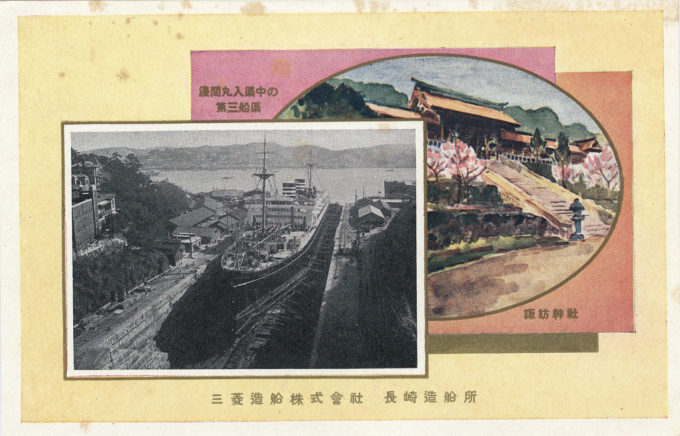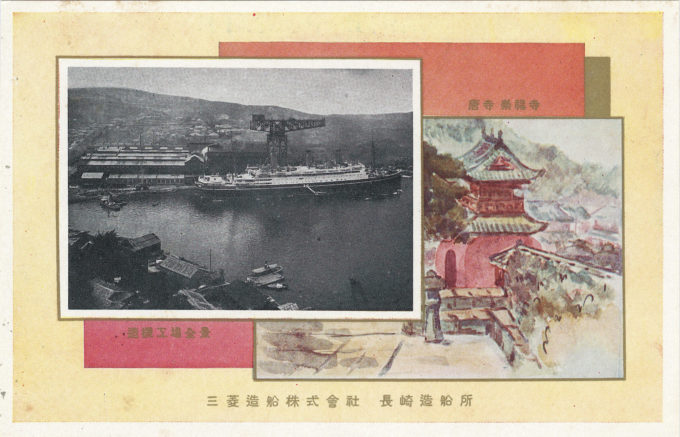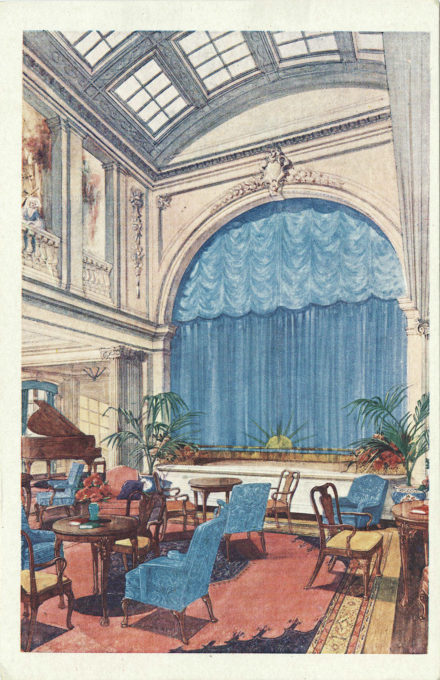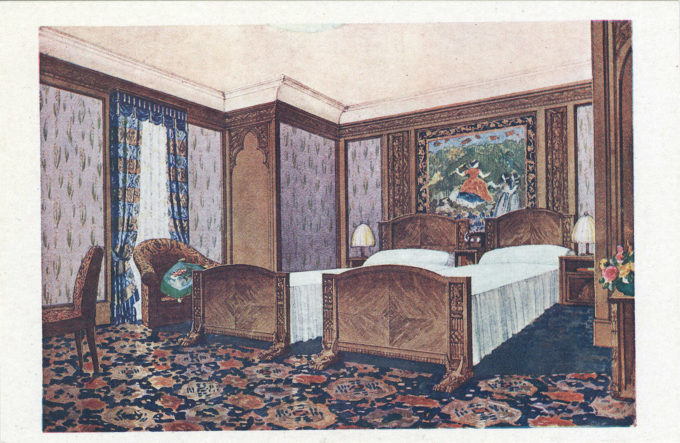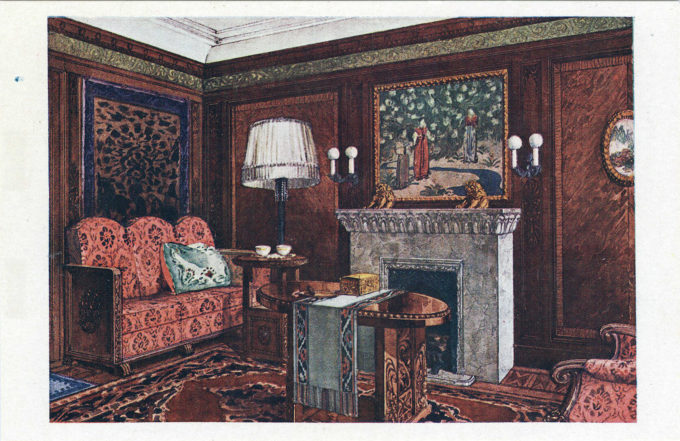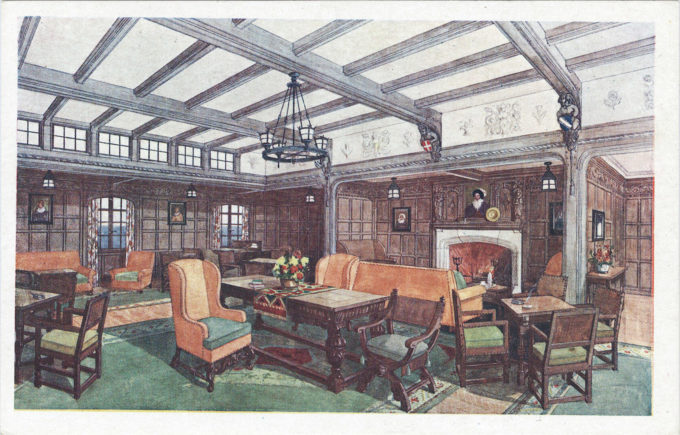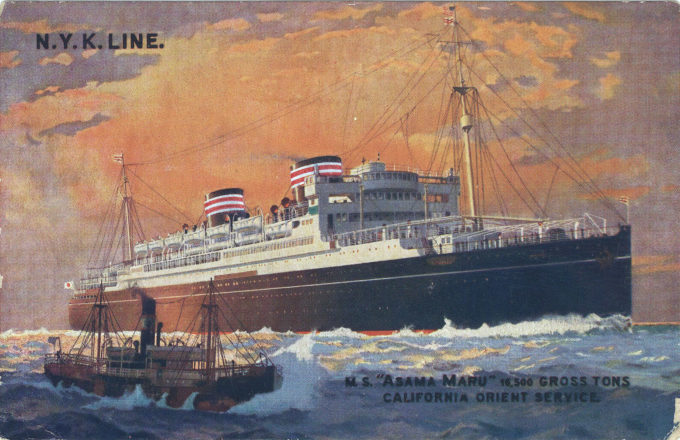
M.S. Asama Maru, NYK Lines, c. 1930, of the California-Orient Service. On its maiden voyage from Yokohama to San Francisco in in 1929, the Asama Maru set a new speed record for Japanese liners, making the crossing in 12 days vs. the 16-days it once took.
See also:
NYK Line (Nippon Yusen K.K.).
M.S. Chitose Maru, c. 1930.
Yusen (Nippon Yusen Kaisha) Building, Marunouchi, c. 1930.
“Nineteen hundred and thirty is a banner year for the Nippon Yusen Kaisha (NYK), [its] building project far exceeding that of other shipping companies in [Japan] in point of scale as well as quality. Especially, the three luxurious passenger-carrying motor-liners of 17,000 tons each for the California-Orient Service are the last word in the art of shipbuilding, and they are indeed the pride of Japan. These three, which are rightly referred to as ‘superb trio’ by the NYK authorities are the Asama Maru, the Tatsuta Maru, and the Chichibu Maru.
“The Asama Maru, the first ship of the ‘superb trio’ was built and launched in October, 1928, and was fitted out in September of the following year, at the Nagasaki yards of the Mitsubishi Shipbuilding Company, to start on her long-awaited service on the San Francisco line in October, 1929.
- The Asama Maru under construction at the Mitsubishi Docks, Nagasaki, c. 1928.
- The Asama Maru being outfitted at the Mitsubishi Docks, Nagasaki, c. 1929.
“‘Perfect’ is an adjective which does not seem to be strong enough to describe the popularity and enthusiastic admiration that were won on her maiden trip; all the passengers were more than pleased with the courteous service, comfortable accommodation, and the pleasant speed. In fact, this largest motorship that was ever built in Japan covered the whole distance between Yokohama and San Francisco in 12 days … It signifies a reduction of four days in the number of days that was hitherto required by other NYK liners on this run.
M.S. Asama Maru, lounge, c. 1930, ‘decorated in the Georgian style. Convertible into a Grand Ball-room. A regular stage is provided for cinema shows and other performances.’
“… On board the Asama Maru, the dining saloon at the center of the ‘C’ deck is finished after the fashion of the early Georgian period. Its walls are panelled with painted mahogany plywood and groups or single cylindrical columns of black marble finish, with ornate gilded capitals which give the room a magnificent appearance.
“… The lounge … situated amidships on ‘A’ deck, is also decorated according to the Georgian style … Blue is prominent in the coloring of the curtain and chairs of the lounge of the Asama Maru … The floor of the room is inlaid with oak-wood block parquetry and covered with huge rugs, soft and colorful. By removing the rugs, it can instantly be converted into a perfectly-floored grand ball-room of 2,000 square feet wherein the passengers may enjoy dancing to the accompaniment of the ship’s orchestra. A regular stage with a lofty, semi-circular proscenium arch is at the fore end of the room … and [a] grand piano, footlights, and other necessary paraphernalia for theatrical or concerts are provided. In addition, high above on the aft end wall a cinema projection room is fixed for the presentation of motion pictures.
“… The two suite-rooms of the Asama Maru were designed and decorated by the Kawashima Orimono-sho of Kyoto and the Takashimaya Department Store of Osaka … The painted-walls-usual-suite room of the Asama Maru was decorated in a quiet, traditional Japanese way.
- M.S. Asama Maru, bedroom of the ‘suite de luxe , c. 1930.
- M.S. Asama Maru, sitting room of the ‘suite de luxe’, c. 1930.
M.S. Asama Maru, smoking room, c. 1930, ‘in the style of the early Tudor period. Mah jong sets and requisites for various other games are provided for general use.’
“… Both the Asama Maru and the Tatsuta Maru have galleries, 60 feet long, on the port and starboard sides, constituting the passageway from the lounge to the smoking room. Their decoration of the Georgian period is in uniform with that of the lounge, and comfortable settees, chairs, and writing tables are placed here for the convenience of passengers … Also, there are a swimming pool, adjoining gymnasium, a regular bank, nursery, and many other delightful accommodations to make the journey on these liners thoroughly enjoyable.”
– The Far Eastern Review, March 1930
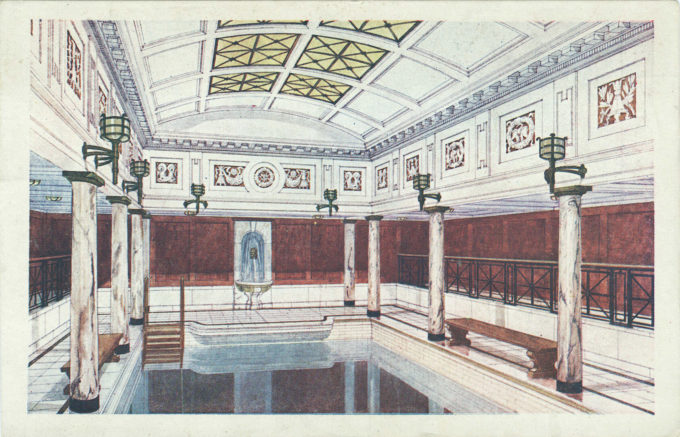
M.S. Asama Maru, swimming pool, c. 1930, ‘constructed in Roman style. Dressing cubicles, fresh water shower-bath, and drying room are attached.’
“An impressive ship of its day, the Asama Maru spanned close to 600 feet in length and was capable of comfortably housing over 800 passengers (more than 200 in first class).
“One of two flagships of the Nippon Yusen Kaisha (NYK) fleet, it had set a new record for the fastest crossing of the Pacific Ocean on the Yokohama-San Francisco route shortly after its launch in 1929.
“As a luxury liner in the true sense of the phrase, it offered a full range of amenities on board, from exotic menus and a hair salon to a library and traditional Kabuki theater performances, and a main dining room outfitted in mahogany and adorned with marble columns. At the time, it was quite possibly the finest way to travel from America to Japan and beyond.”
– Theos Bernard, the White Lama: Tibet, Yoga, and American Religious Life, by Paul G. Hackett, 2012


